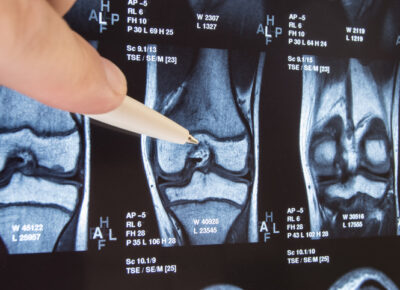“Arthritis” is a term used to describe inflammation of the joints. Osteoarthritis (OA) is the most common form of arthritis and usually is caused by the deterioration of a joint. Typically, the weight-bearing joints are affected, with the knee and the hip being the most common.
An estimated 27 million Americans have some form of OA. OA affects daily activity and is the most common cause of disability in the US adult population. Although OA does not always require surgery, such as a joint replacement, it has been estimated that the use of total joint replacement in the US will increase 174% for hips and 673% for knees by the year 2030.
The cause of OA is unknown. Current research points to aging as the main cause. Factors that may increase your risk for OA include:
- Age. Growing older increases your risk for developing OA because degeneration and aging of the cartilage and synovial fluid increases over time.
- Genetics. Research indicates that some people’s bodies have difficulty forming cartilage. Individuals can pass this problem on to their children.
- Past injury. Individuals with prior injury to a specific joint, especially a weight-bearing joint (such as the hip or knee), are at increased risk for developing OA.
- Occupation. Jobs that require repetitive squatting, bending, and twisting (e.g., construction, landscaping, childcare) are risk factors for OA. People who perform jobs that require prolonged kneeling (e.g., miners, flooring specialists) also are at elevated risk.
- Sports. Athletes who repeatedly use a specific joint in extreme ways (e.g., pitchers, football linemen, ballet dancers, runners) and those who engage in high-impact joint loading done in a repetitive manner (e.g., running, jumping, landing on hard surfaces) may increase their risk for developing OA later in life.
- Obesity. Being overweight causes increased stress to weight-bearing joints like knees, increasing the risk for development of OA.
Everest Rehabilitation physical therapy treatment has proven to provide effective treatment for OA. Everest Rehabilitation Services physical therapists may help you avoid surgery and use of prescription painkillers. Although the symptoms and progression of OA are different for each person, starting an individualized exercise program and addressing risk factors can help relieve your symptoms and slow the condition’s advance.
Your Everest Rehabilitation Services physical therapist may:
- Perform a thorough examination to determine your symptoms
- Observe what activities are difficult for you
- Design an individualized exercise program to address your specific needs and improve your movement
- Use manual (hands-on) physical therapy to improve movement of the affected joint
- Offer suggestions for adjusting your work area to lessen the strain on your joints
- Teach you aerobic and strengthening exercises to improve your movement and overall health
- Design and teach you a home-exercise program to improve your strength and movement
- Teach you an exercise program for safe weight loss, if you need to lose weight to ease pressure on your joints
- Recommend simple lifestyle changes that will help keep the weight off
In cases of severe OA that are not helped by physical therapy alone, surgery, such as a knee or hip replacement, may be necessary. Your physical therapist will work you’re your surgeon to provide the treatment plan that will lessen pain and improve movement post-surgery.

